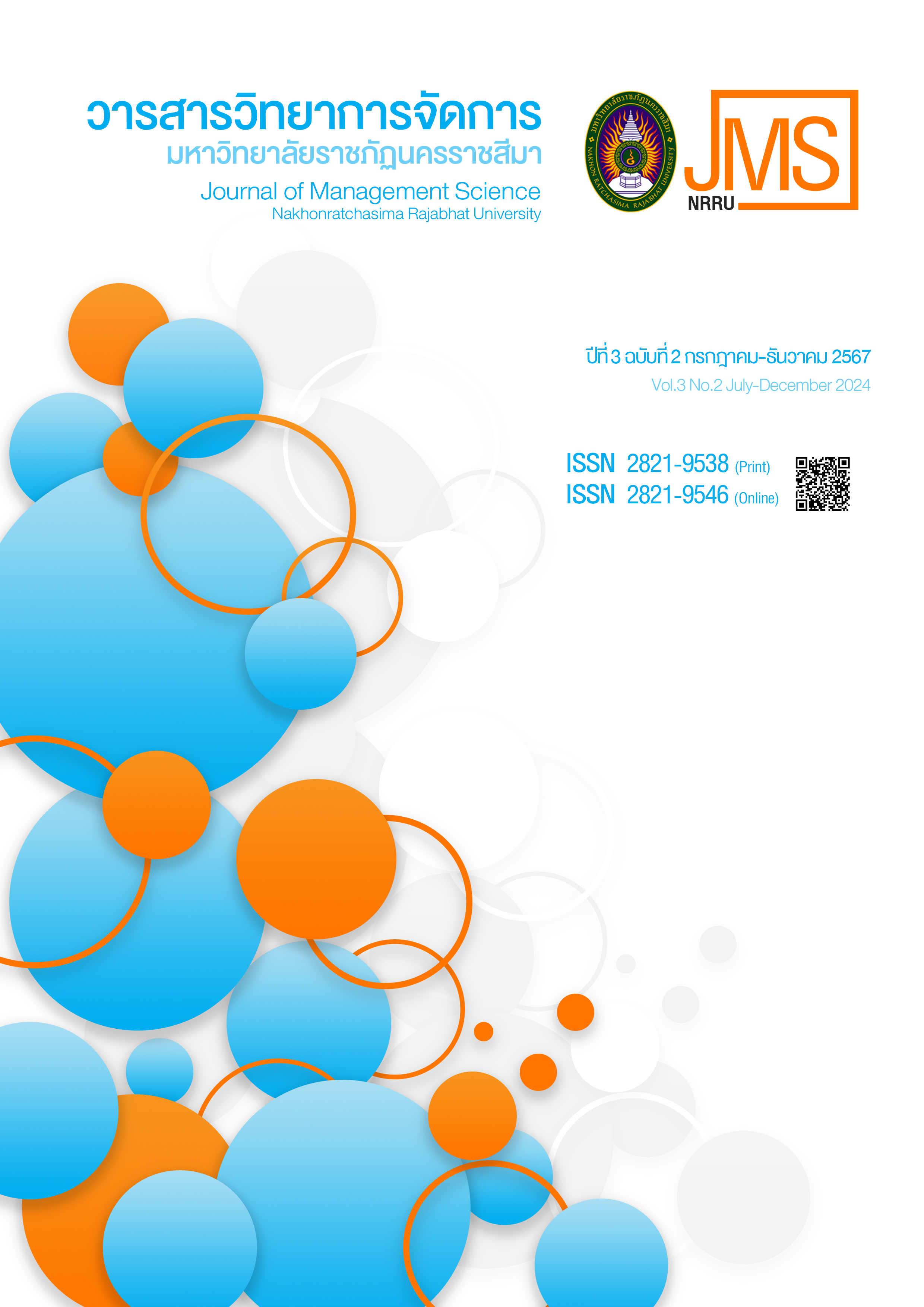[RETRACTED ARTICLE]Application of Beliefs and Innovations to Support Creative Tourism Policy during the COVID - 19 Pandemic in Roi Kaen - Sarasin Area
Main Article Content
Abstract
Announcement of Article Retraction
The Journal of Management Science Nakhon Ratchasima Rajabhat University (JMS NRRU) has submitted a request for journal quality assessment for inclusion in the Thai-Journal Citation Index Centre (TCI) for the year 2025. During the assessment process, it was found that the article entitled: "Application of Belief and Innovation to Support Creative Tourism Policy During the COVID-19 Pandemic in the Roi Kaen Sarn Sun Area", published in JMS NRRU, Vol. 3, No. 2 (July–December 2024), pages 62–74, and authored by Boonpeng Sittiwongsa, contains significant content duplication with the following previously published articles:
- Mahamakut Buddhist University Roi Et Campus Journal, Vol. 12, No. 1 (January–June 2023), pages 530–540, and
- Journal of Organizational Management and Social Development, Vol. 3, No. 1 (2023).
As a result, the editorial board of JMS NRRU hereby formally retracts the aforementioned article from JMS NRRU, Vol. 3, No. 2 (July–December 2024), pages 62–74, , to maintain academic integrity and ethical standards
Article Details

This work is licensed under a Creative Commons Attribution-NonCommercial-NoDerivatives 4.0 International License.
บทความในวารสารเป็นลิขสิทธิ์ของวารสารวิทยาการจัดการ มหาวิทยาลัยราชภัฏนครราขสีมา
บทความที่ปรากฎในวารสารเป็นความคิดเห็นของผู้แต่งเพียงอย่างเดียวซึ่งไม่เกี่ยวข้องกับวารสาร
References
กัลยา วานิชย์บัญชา. (2560). การวิเคราะห์สถิติชั้นสูงด้วย SPSS for Window. พิมพ์ครั้งที่ 12. กรุงเทพฯ :
ห้างหุ้นส่วนจํากัด สามลดา.
ฐาปนี เฮงสนั่นกูล. (2549). พิธีกรรมและความเชื่อท้องถิ่น. กรุงเทพฯ : สำนักพิมพ์แสงดาว.
ณัทชลิดา บุตรดีวงษ์. (2561). การใช้นวัตกรรมและเทคโนโลยีสารสนเทศเพื่อการบริหารสถานศึกษาในศตวรรษที่ 21 ของโรงเรียนแสนสุข สังกัดสำนักงานเขตพื้นที่การศึกษามัธยมศึกษา เขต 18. วิทยานิพนธ์ศึกษาศาสตรมหาบัณฑิต สาขาวิชาการบริหารการศึกษา มหาวิทยาลัยเกริก
ธนาวดี ปิ่นประชานันท์. (2564). การพัฒนากิจกรรมการท่องเที่ยวเชิงสร้างสรรค์เพื่ออนุรักษ์วัฒนธรรมกลุ่มชาติพันธุ์อูรักลาโวยจในพื้นที่เกาะลันตา จังหวัดกระบี่. ปริญญานิพนธ์ศิลปศาสตรมหาบัณฑิต สาขาวิชาการจัดการการท่องเที่ยวแบบบูรณาการ บัณฑิตวิทยาลัย มหาวิทยาลัยศรีนครินทรวิโรฒ.
นิศา ชัชกุล. (2555). อุตสาหกรรมการท่องเที่ยว. พิมพ์ครั้งที่ 4. กรุงเทพฯ : สำนักพิมพ์แห่งจุฬาลงกรณ์มหาวิทยาลัย.
บุญเพ็ง สิทธิวงษา. (กรกฎาคม – ธันวาคม 2563). “การมีส่วนร่วมของประชาชนในการกําหนดนโยบายแผนยุทธศาสตร์จังหวัดอุดรธานี.” วารสารมหาวิทยาลัยมหามกุฏราชวิทยาลัย วิทยาเขตร้อยเอ็ด. 9(2): 636-646.
ปิยธิดา เทพวงค์. (2560). การพัฒนารูปแบบการให้บริการสารสนเทศที่สนับสนุนการเป็นมหาวิทยาลัยวิจัย : กรณีศึกษาห้องสมุดคณะสิ่งแวดล้อมและทรัพยากรศาสตร์. กรุงเทพฯ : มหาวิทยาลัยมหิดล.
พระมหาหรรษา ธมฺมหาโส. (2557). พระพุทธศาสนากับวิทยาการสมัยใหม่. กรุงเทพฯ : มหาจุฬาลงกรณ
ราชวิทยาลัย.
ราชบัณฑิตยสถาน. (2525). พจนานุกรมฉบับราชบัณฑิตยสถาน พ.ศ. 2525. พิมพ์ครั้งที่ 5. กรุงเทพฯ : บริษัท อักษรเจริญทัศน์ อจท. จำกัด.
วารุณี กุลรัตนาวิจิตรา. (2560). ปัจจัยด้านนวัตกรรมทางธุรกิจส่งผลต่อการดำเนินงานของธุรกิจขนาดกลางและขนาดย่อม (ประเภทบริการ). วิทยานิพนธ์วิทยาศาสตรมหาบัณฑิต สาขาการบริหารเทคโนโลยี. วิทยาลัยนวัตกรรม มหาวิทยาลัยธรรมศาสตร์.
วิลาสินี ธนพิทักษ์ และคณะ. (2561). รายงานผลการวิจัยการจัดการท่องเที่ยวเชิงสร้างสรรค์เพื่อเรียนรู้นวัตกรรมฝายมีชีวิตจากภูมิปัญญาชุมชนตำบลเขาปู่ อำเภอศรีบรรพต จังหวัดพัทลุง. สงขลา : มหาวิทยาลัยทักษิณ.
สโรชา อมรพงษ์มงคล. (2561). การจัดการการท่องเที่ยวเชิงวัฒนธรรมในมิติความจริงแท้และการท่องเที่ยวเชิงสร้างสรรค์ กรณีศึกษา: เมืองมัลลิกา ร.ศ.124 จังหวัดกาญจนบุรี. วิทยานิพนธ์ศิลปศาสตรมหาบัณฑิต สาขาวิชาการจัดการมรดกวัฒนธรรมและอุตสาหกรรมสร้างสรรค์ วิทยาลัยนวัตกรรม. มหาวิทยาลัยธรรมศาสตร์.
สุดแดน วิสุทธิลักษณ์ และคณะ. (2556). คู่มือการท่องเที่ยวเชิงสร้างสรรค์. กรุงเทพฯ: องค์การบริหารการพัฒนาพื้นที่พิเศษเพื่อการท่องเที่ยวอย่างยั่งยืน.
สุดสันต์ สุทธิพิศาล. (2555). การท่องเที่ยวชุมชนเชิงสร้างสรรค์. กรุงเทพฯ: สถาบันบัณฑิตพัฒนบริหารศาสตร์
อาหมัดอัลซารีย์ มูเก็ม. (2559). ประเพณี พิธีกรรม ความเชื่อ ที่มีความสัมพันธ์ต่อวิถีชีวิตของชนกลุ่มชาติพันธุ์เขมรบนพื้นที่บ้านจารย์ อําเภอสังขะ จังหวัดสุรินทร์. ประกาศนียบัตรบัณฑิต สาขาวิชาบัณฑิตอาสาสมัคร วิทยาลัยพัฒนศาสตร์ ป๋วย อึ๊งภากรณ์ มหาวิทยาลัยธรรมศาสตร์.
Hughes, R.L. (1999). Leadership : Enhancing the Lessons of Experience. 3rd ed. Boston : McGraw-Hill.
Nord, W. R., & Tucker, S. (1987). Implementing Routine and Radical Innovations. New York : Lexington Books.
Richards, G., & Raymond, C. (2000). “Creative Tourism.” ATLAS News. 23: 16- 20.
Rogers, E. M. (2003). Diffusion of innovations. 5th ed. New York : The Free Press.
UNESCO. (2007). A Training Manual for Heritage Guides Tourism at Cultural Heritage Sites in Asia Cultural Heritage Specialist Guide Training and Certification Programme for UNESCO World Heritage Sites. Macao: UNESCO and Institute for Tourism Studies (IFT), Macao SAR.


